 Research
Research
The research topics at Palmyra are as diverse as the ecosystems on the atoll. To date, Stanford researchers at Palmyra have included faculty and students from the departments of: Biology, Enviromental Earth Systems Science, Civil & Environmental Engineering, Anthropology, the Hopkins Marine Station, and the Enviromental Fluid Mechanics Laboratory.
Coral reefs and climate change research
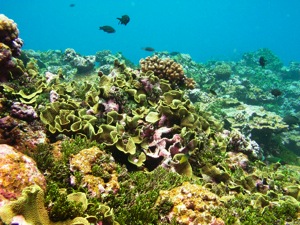 Palmyra presents conditions that are ideal for researching climate
Palmyra presents conditions that are ideal for researching climate
change. Situated at the boundary between the eastern cool
tongue and western warm pools of the Pacific, Palmyra
experiences a broad range of natural variation in pH. Upwelling
along the equator to the east of Palmyra brings low pH waters
from the deep ocean to the surface, where they are entrained in
the equatorial current system and brought past Palmyra. The El
Niño/La Niña cycle subsequently varies equatorial upwelling and
alters the pH of seawater arriving at Palmyra (estimated change
~0.15 pH units interannually). Thus, Palmyra offers an ideal site to
study natural variability of pH as an analog to
human-induced ocean acidification.
Additionally, the chemistry of some of the long-lasting coral structures at Palmyra respond in an important way to environmental change. Certain corals at Palmyra serve to "archive" information on climate change by storing data on ambient conditions in their skeletons. Dr. Rob Dunbar and his colleagues have been leading this research on climate change at Palmyra.
Overfishing and coral reefs
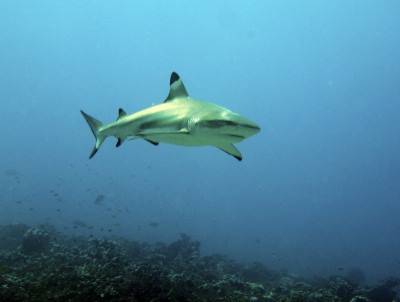 Dr. Fiorenza Micheli uses Palmyra as a model system to advance
her research on the science of marine conservation and
community ecology of coral reefs. Fio’s research with
Stanford undergraduates at Palmyra yielded the first published
report on the uniquely pristine nature of the atoll's fish
communities (Stevenson et al. 2007). Fio has initiated a comprehensive investigation of the
ecology of the abundant large fish present on
Palmyra's reefs via her graduate students. One of these PhD
candidates, Douglas McCauley, is leading an effort to investigate
the role that Palmyra's large fish play in the health and function of
coral reefs. This study employs inter-atoll comparisons,
stable isotopes, and field experiments.
Dr. Fiorenza Micheli uses Palmyra as a model system to advance
her research on the science of marine conservation and
community ecology of coral reefs. Fio’s research with
Stanford undergraduates at Palmyra yielded the first published
report on the uniquely pristine nature of the atoll's fish
communities (Stevenson et al. 2007). Fio has initiated a comprehensive investigation of the
ecology of the abundant large fish present on
Palmyra's reefs via her graduate students. One of these PhD
candidates, Douglas McCauley, is leading an effort to investigate
the role that Palmyra's large fish play in the health and function of
coral reefs. This study employs inter-atoll comparisons,
stable isotopes, and field experiments.
Species invasion and biogeochemistry
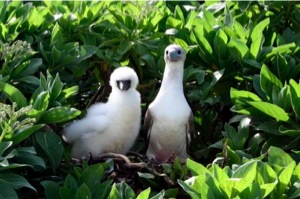 Dr. Rodolfo Dirzo and graduate student Hillary Young have
turned their focus to the terrestrial ecosystem, investigating the
mechanisms by which the proliferation of the coconut palm (Cocos nucifera)
at Palmyra alters atoll nutrient cycling. Results suggest that the presence of the palm causes nutrient depletion by changing marine inputs to the system, ultimately resulting in changes throughout the foodweb. The Dirzo lab is also
specifically examining the movement of nutrients between land and sea, finding that most nutrients in the forest system are brought by birds from distant locations. Collaborating with Stanford's Barbara Block and Scott Shaffer (UC Santa Cruz), they have been tracking seabirds using GPS telemetry and stable isotopes. These tracks, combined with physical collections of nutrient inputs from the birds, are allowing the research team to pin down the origins and nature of island nutrient inputs, creating a physical and quantitative map of nutrient movement between forest and pelagic ecosystems. The tracking data is already yielding interesting behavioral data concerning how and where Palmyra’s seabirds feed.
Dr. Rodolfo Dirzo and graduate student Hillary Young have
turned their focus to the terrestrial ecosystem, investigating the
mechanisms by which the proliferation of the coconut palm (Cocos nucifera)
at Palmyra alters atoll nutrient cycling. Results suggest that the presence of the palm causes nutrient depletion by changing marine inputs to the system, ultimately resulting in changes throughout the foodweb. The Dirzo lab is also
specifically examining the movement of nutrients between land and sea, finding that most nutrients in the forest system are brought by birds from distant locations. Collaborating with Stanford's Barbara Block and Scott Shaffer (UC Santa Cruz), they have been tracking seabirds using GPS telemetry and stable isotopes. These tracks, combined with physical collections of nutrient inputs from the birds, are allowing the research team to pin down the origins and nature of island nutrient inputs, creating a physical and quantitative map of nutrient movement between forest and pelagic ecosystems. The tracking data is already yielding interesting behavioral data concerning how and where Palmyra’s seabirds feed.
Molecular ecology
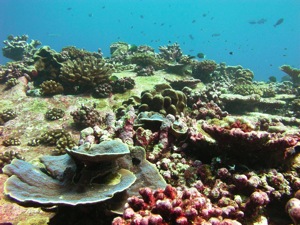 Palmyra has played an important role in the studies conducted by Dr.
Steve Palumbi and graduate student Tom Oliver. The Palumbi
lab is examining functional diversity of zooxanthellae, the
symbiont essential to the function of coral reefs. With increasing
concern about global warming and coral bleaching, it is crucial
that the nature of the relationship between coral and
zooxanthellae be better understood. The Palumbi lab uses
genetic techniques to develop and test new markers that allow
them to more accurately genotype these symbionts, build more
resolute phylogenies, and provide information about critically
important functional divergence in zooxanthellae. Functional
diversity or lack thereof may give evidence for distinct population-
level responses to climate change.
Palmyra has played an important role in the studies conducted by Dr.
Steve Palumbi and graduate student Tom Oliver. The Palumbi
lab is examining functional diversity of zooxanthellae, the
symbiont essential to the function of coral reefs. With increasing
concern about global warming and coral bleaching, it is crucial
that the nature of the relationship between coral and
zooxanthellae be better understood. The Palumbi lab uses
genetic techniques to develop and test new markers that allow
them to more accurately genotype these symbionts, build more
resolute phylogenies, and provide information about critically
important functional divergence in zooxanthellae. Functional
diversity or lack thereof may give evidence for distinct population-
level responses to climate change.
Tagging manta rays
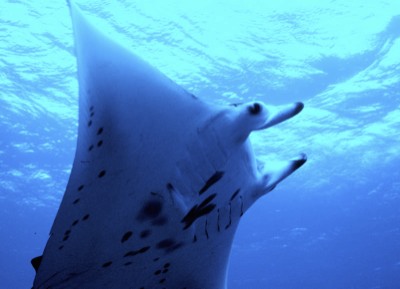 Dr. Barbara Block and her graduate student Chris Perle use
Palmyra as base from which to study habitat use and movement
patterns of manta rays (Manta birostris). Very little is know about
these magnificent creatures, despite the fact that they interact
directly and indirectly with fisheries throughout their range. Dr.
Block's lab uses electronic "Pop-Up" Satellite Archival Tags
(PATs), a recent technology that allows researchers to investigate
habitat utilization in both horizontal and vertical space on time
scales from hours to months. At a preprogrammed date and
time, PATs detach from the animal via a corrosive pin, float to the
ocean surface, and transmit data summaries via satellite. Data
from tags deployed in 2003, 2004, and 2005 have already been
recovered and analyzed, yielding new findings about the natural
history of these animals.
Dr. Barbara Block and her graduate student Chris Perle use
Palmyra as base from which to study habitat use and movement
patterns of manta rays (Manta birostris). Very little is know about
these magnificent creatures, despite the fact that they interact
directly and indirectly with fisheries throughout their range. Dr.
Block's lab uses electronic "Pop-Up" Satellite Archival Tags
(PATs), a recent technology that allows researchers to investigate
habitat utilization in both horizontal and vertical space on time
scales from hours to months. At a preprogrammed date and
time, PATs detach from the animal via a corrosive pin, float to the
ocean surface, and transmit data summaries via satellite. Data
from tags deployed in 2003, 2004, and 2005 have already been
recovered and analyzed, yielding new findings about the natural
history of these animals.
In 2009, undergraduate Paul DeSalles conducted a sister study in Dr. Fiorenza Micheli’s lab on the movement and feeding ecology of manta rays in Palmyra’s interior lagoons. This work was part of his senior thesis in the Stanford Biology Department. In this project Paul employed a different kind of tracking technology: acoustic telemetry. This style of tracking employs acoustic tags which emit a regular ultrasonic signal that allowed researchers to follow a manta’s path of travel and collect high resolution data on where mantas feed, what depths they use, and which habitats they prefer. Results from this work provide a valuable look at how mantas use lagoon ecosystems.
Impacts of fishing on marine parasites
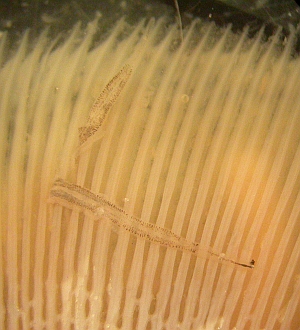 Relatively unimpacted by human industry, Palmyra offers researchers the chance to see what ocean ecosystems were like before they were altered by large-scale anthropogenic disturbances. Dr. Fiorenza Micheli and graduate student Chelsea Wood are taking advantage of this "window into the past" to test the hypothesis that marine parasites were more abundant before the onset of industrial fishing. Because fishing dramatically reduces the density of fish (reducing transmission efficiency of directly transmitted parasites), selectively removes large, old, high trophic level fish (which carry proportionally more parasites than smaller, younger, lower trophic level fish), and substantially reduces food web complexity (reducing transmission efficiency of trophically transmitted parasites), fishing has probably driven a global decline in fish parasites. Fio and Chelsea plan to test this hypothesis by installing fenced exclosures to manipulate the fish community on Palmyra's lagoon flats and measuring resulting changes in parasites. Parasites, though harmful to their hosts, are a critical component of global biodiversity and play an important role in shaping ecological communities; their loss could have important effects on ocean ecosystems, and research on Palmyra will help to establish whether such a loss has occurred.
Relatively unimpacted by human industry, Palmyra offers researchers the chance to see what ocean ecosystems were like before they were altered by large-scale anthropogenic disturbances. Dr. Fiorenza Micheli and graduate student Chelsea Wood are taking advantage of this "window into the past" to test the hypothesis that marine parasites were more abundant before the onset of industrial fishing. Because fishing dramatically reduces the density of fish (reducing transmission efficiency of directly transmitted parasites), selectively removes large, old, high trophic level fish (which carry proportionally more parasites than smaller, younger, lower trophic level fish), and substantially reduces food web complexity (reducing transmission efficiency of trophically transmitted parasites), fishing has probably driven a global decline in fish parasites. Fio and Chelsea plan to test this hypothesis by installing fenced exclosures to manipulate the fish community on Palmyra's lagoon flats and measuring resulting changes in parasites. Parasites, though harmful to their hosts, are a critical component of global biodiversity and play an important role in shaping ecological communities; their loss could have important effects on ocean ecosystems, and research on Palmyra will help to establish whether such a loss has occurred.
Undergraduate research
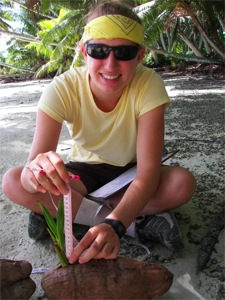 One of the most valuable outcomes of Stanford's participation in PARC
is the opportunity that it has presented for Stanford undergraduates to
participate in the aforementioned projects and begin their own
independent research. Six undergraduates traveled to Palmyra during
the summer of 2007 to work as research assistants on Stanford-led
One of the most valuable outcomes of Stanford's participation in PARC
is the opportunity that it has presented for Stanford undergraduates to
participate in the aforementioned projects and begin their own
independent research. Six undergraduates traveled to Palmyra during
the summer of 2007 to work as research assistants on Stanford-led
research projects, followed by five undergraduates in the summer of
2008, and seven in 2009. Undergraduate help is instrumental in
supporting Stanford research at Palmyra, and it also offers undergraduate students a
one-of-a-kind field research opportunity. This unique experience was
principally made possible by funding from the Office of the Vice Provost for
Undergraduate Education. Click here to visit the undergraduate
Palmyra research website. Click here to visit the Stanford 2009 Palmyra blog.
Another important avenue by which undergraduates are able to do research at Palmyra is by sailing aboard the SSV Robert C. Seamans with Stanford@SEA. Renowned for its abundance of flora and fauna, Palmyra typically becomes the focus of many of the independent research projects that students conduct for this course. Stanford's membership in PARC allows our students to use the lab and the research tools at the PARC Research Station. Some 76 undergraduates have visited and conducted research at Palmyra as part of this program, which has occurred every other year since 2003. Stanford@SEA's student research at Palmyra has focused on myriad topics, including lagoonal circulation patterns, the ecology of coral bleaching, tracking Palmyra's seabirds with electronic tags, the effects of fish initiated herbivory and coralivory, and research on Palmyra's apex predators. Click here to view the Stanford@SEA website.
Research collaboration
Participation in PARC has fostered much new collaboration between Stanford faculty/students and scientists at other institutions. The nature of conducting ambitious research at a remote location has encouraged many close associations between Stanford scientists and colleagues from elsewhere. Thus far, collaborations include links between Stanford and the Scripps Institution of Oceanography; American Museum of Natural History; California Academy of Sciences; University of California at Santa Barbara; University of California at Irvine; University of California at Santa Cruz; University of Hawaii; US Geological Survey; Victoria University of Wellington, New Zealand; The Nature Conservancy; and US Fish and Wildlife Service.